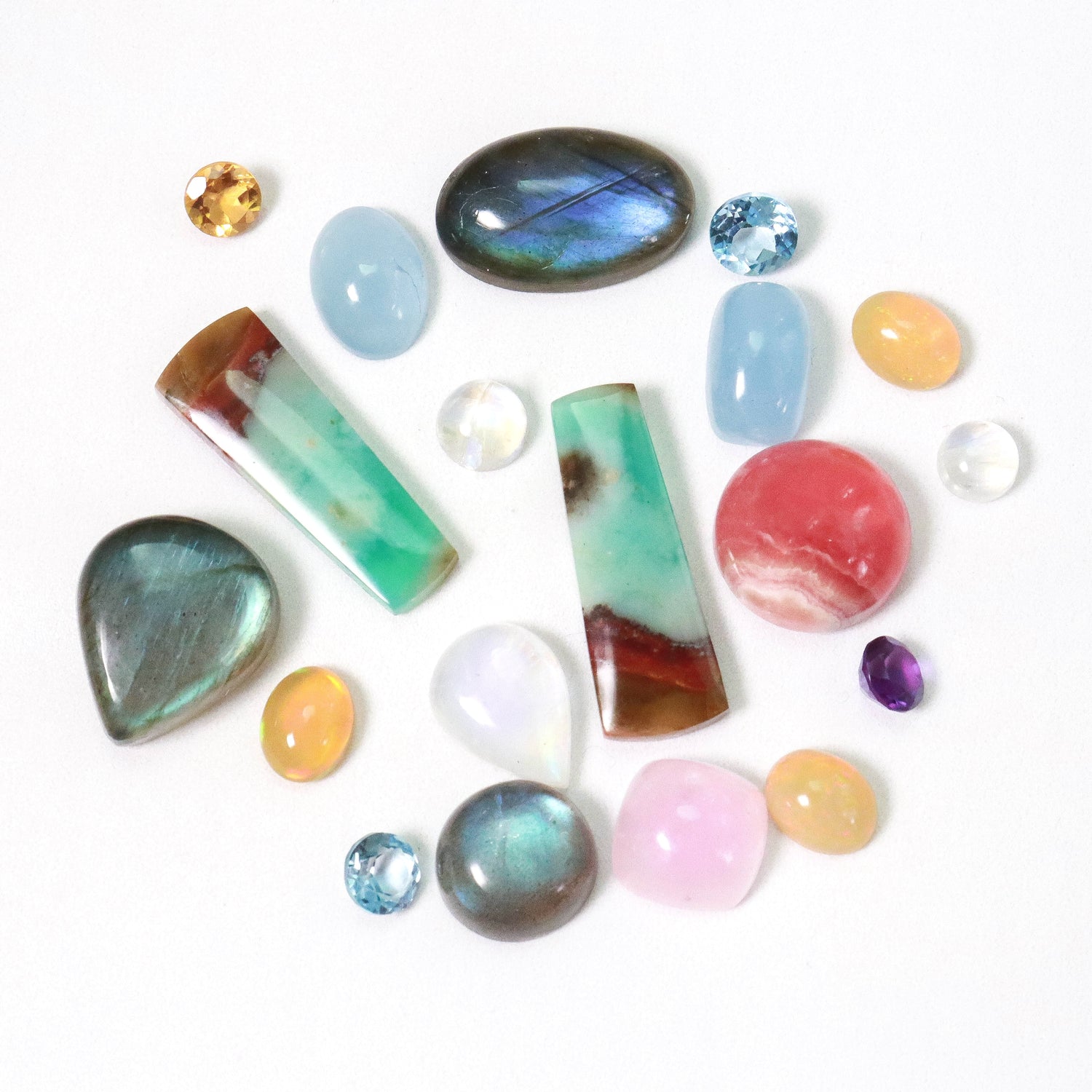Glossary of Gems
A brief description of frequently used gemstones...
-
AQUAMARINE
Aquamarine is a stone which represents the meaning “ the color of the sea”. Aqua means “water” and Marina means “of the sea”. It is a green-blue to blue color mineral beryl. It is in the same family as the green variety, Emerald, and pink variety, Morganite. The Aquamarine blue color stone offers an array of translucent to transparent blue colors from pale to vibrant rich blue.
Aquamarine is the birthstone of March.
-
AMETHYST
A popular and recognizable rich purple gemstone. It is a variety of mineral quartz species. Its purple color ranges from a light lavender to a to deep violet purple, and from a bluish purple to a reddish purple. A gemstone with an ancient royal and regal history, it is a durable and beautiful gemstone.
Amethyst is the birthstone for February.
-
CITRINE
A transparent quartz mineral that is a popular gem for yellow color.
It ranges from pale yellow, to vivid yellow, to a brownish or reddish orange.
The more reddish orange colors of Citrine is often called Madeira Citrine.
Citrine combined in a bicolor zoning with Amethyst results in a stone of Ametrine.
Citrine along with Topaz is the Birthstone for November.
-
LABRADORITE
A stone where the colors seem to play and dance.
With a dark base, colors of blue, red, orange, yellow and green play across the stone in an iridescent effect specific to Labradorite referred to as Labradorescence. It is a feldspar mineral in the plagioclase named for where it was found in Labrador, Canada.
-
LAPIS LAZULI
Also simply referred to as Lapis, is a vivid rich blue color gemstone with sprinkles of Pyrite.
The lapis color can range from medium grayish blue to an intense royal blue. Pyrite, also known as “fools gold” is a metallic luster mineral in a brassy- yellow color.
Lapis is a rock composed of many minerals that contribute to the stones distinctive color and composition. Lapis Lazuli has a a long and storied history since ancient times.
Other uses include sculpting, and pigments.
-
MALACHITE
A distinctively green stone of concentric bands in varying shades of green. The colors range from light, to bright, to a very dark green,
It is an opaque stone with an artistic quality because of its unique one of kind patterning.
Presence of copper gives Malachite its beautiful colorations.
Malachite’s diversity in its uses include jewelry, carvings, sculpture, and pigments for paintings.
-
MOONSTONE
A beautiful and alluring stone. It’s most obvious and striking quality
is the moonstone’s shimmer and glow called Adularescence. The soft glow of light gives this stone its magical appearance as though it captured the moonlight.
It is a feldspar mineral in the orthocalse with flashes of blue or multicolor.
There are other color varieties of Moonstones such as orange and gray.
Moonstone which displays a spectrum of colors is referred to as “rainbow moonstone”.
Those born in the month of June can call Moonstone their birthstone.
-
MORGANITE
A mineral beryl variety in an array of pinks from yellowish orange, to orangy pink, to even a purply bluish pink.
It is a variety that is sibling to Aquamarine and Emerald. It is the presence of trace amounts of manganese that it gets its pink color.
It is a beautiful transparent and romantic gemstone naturally light in color.
Morganite gets its name from American banker J.P. Morgan.
-
OPAL
One of the most distinct and striking yet delicate gemstones.
Opals are characterized by their kaleidoscopic and fiery play of colors.
Color seems to dazzle and dance across the stone.
Opal is a hydrated silicon dioxide stone, which means it has water in its structure.
Water from rains seeped deep underground carrying with it deposits of silica. Periods of dryness caused the water to evaporate leaving the deposits of silica in the cracks of underground rock. The silica remains as what created Opal.
It is a transparent to opaque and comes in types, Black Opal, White Opal, Fire Opal, Boulder Opal, and Clear Opal.
Through Opal's array of qualities, the most distinguishing factor is the beautiful spectacle of color.
Opal is the Birthstone of October.
-
TOURMALINE
A large mineral family of stones in varying vibrant colors. Covering most colors of the rainbow, all Tourmalines closely share the same physical structure, but it’s the chemical composition and presence of trace elements that influence their different colors. Tourmaline has the largest color range of all the species of gems. If one color is not enough, Tourmalines also come bi-color. This bi-color is called zoning. Tourmaline is a very popular gemstone mined from all over the world,
Tourmaline is the Birthstone of October
-
TOPAZ
Topaz comes in a large range of colors from blue, golden yellow, and colorless with pink and orange being the rarest. Topaz is a silicate mineral.
Topaz is the Birthstone of November
-
TURQUOISE
A highly recognizable gemstone that is much loved and adored is filled with great character.
It is an opaque mineral with color ranges in sky blue to blue green, green, bluish green and yellowish green. The colors of Turquoise are altered by the presence and proportions of iron and copper in its composition.
Turquoise that has a spider webbing appearance contains inclusions of the host rock in which it is cut from. Some may enjoy the uniqueness of the webbing as adding a bit of interest to the stone.
Turquoise is acceptably treated and enhanced to improve its stability and durability as a stone for jewelry.
Turquoise is the December Birthstone




